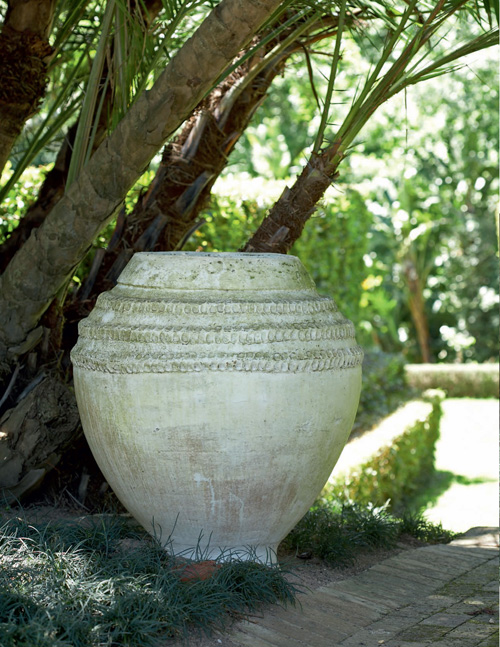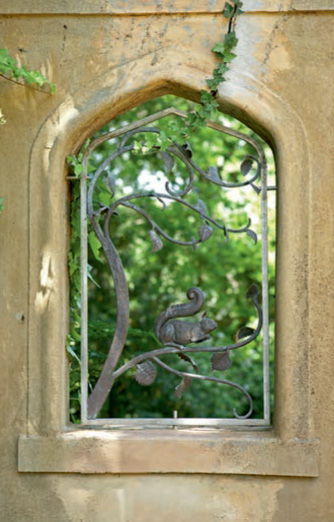
Liz enjoys a creative challenge, tackling a project in a different area of the Cellars-Hohenort Hotel’s garden each year. This original iron sculpture was the result of her own talent and that of Simon Beebe.

Liz enjoys a creative challenge, tackling a project in a different area of the Cellars-Hohenort Hotel’s garden each year. This original iron sculpture was the result of her own talent and that of Simon Beebe.

A reflecting canal. This construction was a technical challenge because of the sloping ground as well as the remains of the foundations of an old outbuilding. Liz opted for the quiet of a reflecting canal rather than the ubiquitous koi pond.
The flowers in this section of the garden are echoed in the still water. Says Liz, ‘We decided to keep it an all-white garden and planted it with standard Iceberg roses plus a variety of other white flowers such as alyssum, white irises, white agapanthus and shasta daisies. Being a hotel, we aim to keep the gardens flowering through the different seasons for the delight of our guests. We also select flowers and plants that are at peak performance during our busiest months.’

Photographed just before full bloom, this beautiful lilac-coloured creeper, Clytostoma callistegioides, covers the full length of this arbour. The beddings beneath were recently replanted with a selection of plants in lilac hues, such as scaevola, scaviosa, salvia, purple alyssum, agapanthus and aquilegia.

The palm fronds create an exotic backdrop for this huge and handsome vessel.

The remains of an old oak have been preserved as a tribute to nature’s own sculpture.

The lower end of the garden is a bog planted with giant Australian tree ferns. This bench, hand-crafted from alien wattle by crafters in disadvantaged communities, is located for visitors to enjoy the cool, shady part of the garden on hot summer days. During winter, bluebells appear as a carpet of blue.
Liz’s most treasured trees are the giant camphors that were planted in between the oak trees way back in the early days of the Constantia farmlands. The original oaks have long since died, but the camphor trees continue to flourish. They were apparently brought over as slips in the Dutch East India Company ships that called at the Cape during the eighteenth century.
The only woman in the world to own three hotels with Relais & Chateaux status, Liz McGrath has won many awards including, most recently, the Relais & Chateaux Garden Trophy for 2010. She undertook the renovation of her first hotel, The Plettenberg in Plettenberg Bay, mainly as a distraction after her husband died. Liz and Gerald McGrath shared a passion for food and gardens and travelled with purpose, seeking out hotels all over the world that were known for their kitchens and their ambience.
Her hobby soon became a serious commitment. After the Plettenberg came The Cellars, which took its name from the wine cellars of the Hohenort estate in Constantia. The Cape Dutch house of the original farm had been demolished and a large family home built on its foundations. When Hohenort came onto the market, Liz bought it, remodelled it entirely and renamed the hotel ‘The Cellars-Hohenort’.
Hohenort’s once-lovely garden had been seriously neglected. It was a challenge Liz simply could not resist. She explains: ‘I wanted to transform it into a beautiful and interesting South African garden for my visitors to enjoy, but I needed someone with my passion and vision to help me.’
New to Cape Town from Johannesburg, Liz was visiting Sandy Ovenstone’s garden on one of its well-known open days. ‘On an impulse I asked the woman responsible for the ticket sales if she knew anyone who might be interested in working with me on the Cellars-Hohenort garden project. “What about me?” this utterly charming person replied.’ It was Jean Almon, newly arrived in Cape Town from Zimbabwe and desperately missing her garden. Since then, Liz and Jean have worked in happy harmony.

A wrought-iron squirrel at the window looks through to the rustic garden.
‘I am not interested in instant gratification. I like a garden to evolve and mature gracefully.’